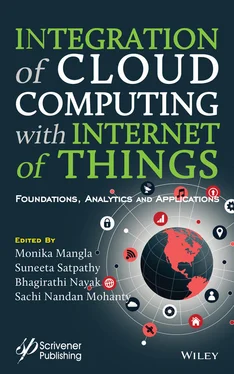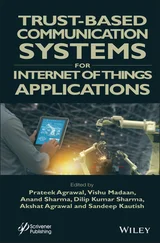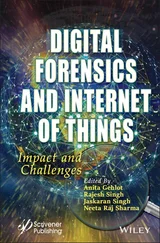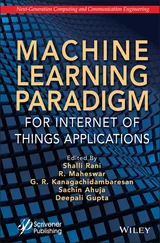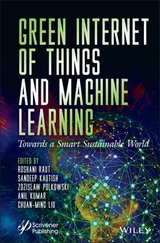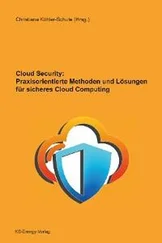Library of Congress Cataloging-in-Publication Data
ISBN 978-1-119-76887-6
Cover image: Pixabay.Com
Cover design by Russell Richardson
Set in size of 11pt and Minion Pro by Manila Typesetting Company, Makati, Philippines
Printed in the USA
10 9 8 7 6 5 4 3 2 1
Advancements in digital technology have brought about revolutionary changes to our lives. These changes are enabled by interconnected devices driven by the Internet of Things (IoT) and Cloud computing, which allow resource sharing on platforms for storage, management and further analysis. The IoT is a novel computing platform that has virtually interconnected a variety of physical objects, empowering them to interchange data and services with less human interaction. Such technology is thought to fuse the physical world with the digital world. On that note, cloud computing is promising for its off-loading storage as well as third party computing capability, which seem to grow exponentially. So, on one hand the ubiquitous smart devices and gadgets have become the foremost aspect of computing and on the other hand the integration of cloud computing with the IoT has amended the computing scheme. The assimilation of cloud computing with IoT, also known as Cloud-IoT, has proven potential for enhancement of the quality of human life and the efficient utilization of resources for smart homes, cities, education, healthcare, banking, industry and grids among others. Moreover, Cloud-IoT technology also benefits from the competence of big data and its analytical facilities.
So, its encroachment upon our lives due to the explosion of such technology and the increasing use of smart devices enabling autosensing, communication, activation and classification capabilities, have enabled the integration of the IoT with cloud computing, which in turn has increased the number of research topics in different fields. Along with these two technologies, Fog computing has also gained popularity in the field of smart cities, smart transportation, smart grids, manufacturing and healthcare, improving the availability of information storage, computation capability as well as networking services between machines and data centers.
With the above facts in mind, the main purpose of this book is to present a detailed overview of the state-of-the-art in Cloud-IoT and its foundations, analytics and applications, as well as to address various security and privacy challenges facing the use of this technology. Our key intention is to discover potential research directions and provide a reference for researchers, students and practitioners in areas relating to the IoT, cloud computing and fog computing; and smooth the way towards progress in the field by providing insight into the use of these technologies in diversified fields of science and areas of application.
The editors would like to acknowledge the assistance and contribution of all those engaged in this project, without whose support this book would not have become a reality. We would especially like to express our most sincere thanks to the contributing authors and the reviewers involved in the review process, who contributed their time and expertise to ensure the eminence, consistency and correct arrangement of the chapters. Finally, we would like to take the opportunity to express our thanks to those at Scrivener Publishing for giving this book its final form.
The EditorsJanuary 2021
The editors would like to acknowledge the assistance of all the people engaged in this book project and especially to the contributing authors and the reviewers involved in the review process. Our sincere thankfulness goes to each one of the chapter’s authors for their contributions, without their support this book would not have become a reality. Our heartfelt gratitude and acknowledgement also goes to the reviewers who contributed their time and expertise for improving the eminence, consistency, and contented arrangement of the chapters in the book.
1
Internet of Things: A Key to Unfasten Mundane Repetitive Tasks
Hemanta Kumar Palo* and Limali Sahoo
Department of Electronics and Communication Engineering, ITER, Siksha ‘O’ Anusandhan (Deemed to be University), Bhubaneswar, India
Abstract
The emergence of the Internet of Things (IoT) finds its footprints in many vivid application domains such as Cognitive Science, Artificial Intelligence, Mobile-first, Blockchain, Biomedical Engineering, Immersive Experience, Zettabyte Era, Micro-service Architecture, Robotic Process, 3D Alteration, Automation, Quantum Computing, etc. These trending technologies are likely to rule the future world in the coming years and make it a must for the industries, and academia. It will arguably change our perception of living by connecting everybody and almost everything placed anywhere in this world. It has recently found its presence in everyday human life connecting a host of home appliances such as the refrigerators, washing machines, microwaves, water taps, clocks, homewares, and even the cooking vessels or pots. It is difficult to imagine things or appliances without the IoT we use today. However, to maintain sustainability, these devices need to be economically viable, ecofriendly, and energy-efficient. This motivates the authors to coin the concept of IoT and its application domains in the current scenario and the way ahead. Some of the major areas of IoT platforms that sensitize the digitized world have been highlighted with special emphasis on the concepts of cloud, fog, edge, and virtual computing.
Keywords:Internet of things, green computing, cloud computing, fog computing, edge computing, virtual computing, semantic IoT
The advents of green computing and green technology make the Internet of Things (IoT) an emerging field of research in recent years. Many vivid application domains such as cognitive science, Artificial Intelligence, biomedical engineering, Micro-service Architecture, Robotic Process, etc. are the outcomes of the IoT technology [1]. Any IoT domain is associated with a set of equipment, devices, machines, home appliances, agricultural or medical instruments, smart vehicles, hardware (servers, monitors, printers, sensors, actuators, etc.), software, and communication network. It is an essential commodity today that finds its footprints in smart homes or smart cities, educational institutes, smart vehicles, agriculture, wearable technologies such as sensors, or wearable devices using remote controls for monitoring and management [2]. The thrust areas of IoT devices are to provide efficient lighting, heating, air conditioning, security, media, and communication, e.g., the provisioning of much needed care and assistance to disabled, sick, or elderly individuals [3]. Some of the major areas of IoT platforms that occupy in the current scenario are shown in Figure 1.1.

Figure 1.1Major areas of IoT platform.
In recent years, the IoT domain has been extended to provide enhanced tags to monitor and control the human affective states. Such attempts can be found useful in the field of criminal investigations, lie detection, an advanced warning to in-car board systems, on-line tutoring, computer games, security, banking, human resource planning, call centers, child psychology, etc. [4–9]. The associated devices and technologies can be effectively utilized in systems such as voice control, pacemakers, advanced hearing aids, Fitbit electronic wristbands, wearable sensors for the people having sight or mobility disabilities. The use of actuators or sensors to cope with an immediate seizure or a sudden fall or similar emergency can help people or patients of all ages in the home and work environment [10]. The additional security devices mounted on the body or its part will alert nearby individuals including the health attendants or medicos at the right time hence can enhance the quality of living being.
Читать дальше
